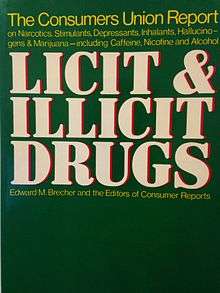Licit and Illicit Drugs
Licit and Illicit Drugs is a 1972 book on recreational drug use by medical writer Edward M. Brecher and the editors of Consumer Reports.[1]
 | |
| Author | Edward M. Brecher |
|---|---|
| Country | United States |
| Subject | Recreational drug use |
| Publisher | Little, Brown and Company |
Publication date | 1972 |
| Pages | 623 |
| ISBN | 978-0316107174 |
Summary
The book describes the effects and risks of psychoactive drugs which were common in contemporary use for recreational and nonmedical purposes.[2] The New York Times paraphrased some major arguments from the book, saying "'Drug-free' treatment of heroin addiction almost never works", "Nicotine can be as tough to beat as heroin", and "Good or bad, marijuana is here to stay. The billions spent to fight it are wasted dollars."[3] The book identifies marijuana as the most popular drug after tobacco, alcohol, and nicotine.[4] A reviewer for the Journal of the American Medical Association summarized it by saying that "Brecher holds that the division of drugs into licit and illicit categories is medically irrational and rooted mainly in historical and sociological factors."[5]
The book's 10 main sections are titled as follows:[1]
- The Narcotics: Opium, Morphine, Heroin, Methadone, and Others
- Caffeine
- Nicotine
- Alcohol, the Barbiturates, The Tranquilizers, and Other Sedatives and Hypnotics
- Coca Leaves, Cocaine, The Amphetamines, "Speed", and Cocaine Again
- Inhalants and Solvents and Glue Sniffing
- LSD and LSD-like Drugs
- Marijuana and Hashish
- The Drug Scene
- Conclusions and Recommendations
Reception
In the Annals of Internal Medicine a reviewer said that the book should be read by every physician who cares for adolescents.[6] In another journal a reviewer described the book as an "important work (which) stresses the historical and social perspectives on the drugs of abuse as well as the current laws, attitudes, and policies concerning all commonly used and abused drugs" and that he was "impressed with the conclusions concerning the failure of the judicial and penal systems" and "that both sides of many controversial issues are presented."[7] Kirkus Reviews described the book as, "Liberal in the best sense, rigorously researched, and free from cant, the Consumer Union Report should become a standard referral."[2]
References
- Brecher, Edward M.; the editors of Consumer Reports (1988). Licit and illicit drugs : the Consumers Union report on narcotics, stimulants, depressants, inhalants, hallucinogens, and marijuana -including caffeine, nicotine, and alcohol (16th print. ed.). Boston: Little, Brown and Company. ISBN 978-0316107174.
- "LICIT AND ILLICIT DRUGS: The Consumer Union Report on Narcotics, Stimulants, Depressants, Inhalants, Hallucinogens, and Marijuana -- including Caffeine, Nicotine and Alcohol by Edward M. Brecher & the Editors of Consumer Reports". Kirkus Reviews. 27 November 1972.
- "Drugs and Edward Brecher". The New York Times. 25 April 1989. Retrieved 17 April 2017.
- Beck, Aaron T.; Wright, Fred D.; Newman, Cory F.; Liese, Bruce S. (1993). Cognitive therapy of substance abuse. New York: Guilford Press. p. 5. ISBN 978-1572306592.
- Liskow, B. I. (1973). "Licit and Illicit Drugs: The Consumers' Union Report on Narcotics, Stimulants, Depressants, Inhalants, Hallucinogens, and Marijuana—Including Caffeine, Nicotine, and Alcohol". JAMA: the Journal of the American Medical Association. 224 (8): 1192–1110. doi:10.1001/jama.1973.03220220090038. PMC 1129374.
- "Licit and Illicit Drugs. The Consumers Union Report on Narcotics, Stimulants, Depressants, Inhalants, Hallucinogens, and Marijuana—Including Caffeine, Nicotine, and Alcohol". Annals of Internal Medicine. 79 (6): 924–921. 1973. doi:10.7326/0003-4819-79-6-924_1.
- Becker, Charles E. (February 1974). "Licit and Illicit Drugs". Western Journal of Medicine. 120 (2): 180. PMC 1129374.